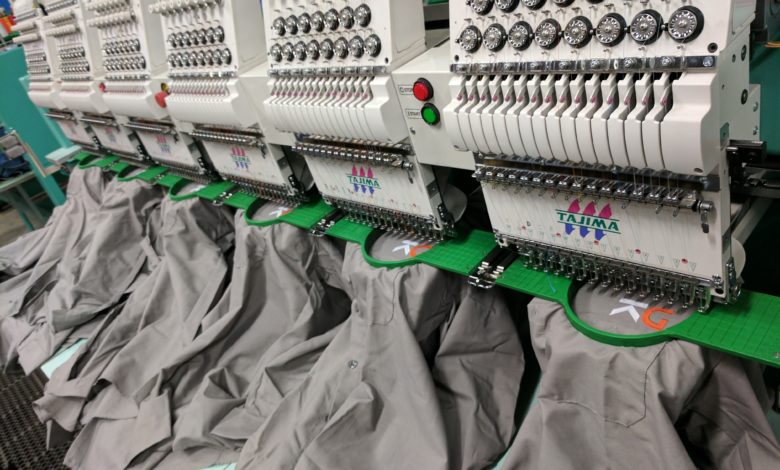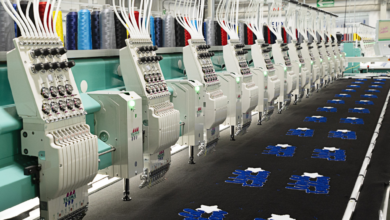
With so many machine manufacturers, software suppliers, and materials vendors realizing the potential of the hobbyist and home decorator market, we aren’t only seeing an expansion of professional products moving into the craft side of the market but also an influx of increasingly capable and well-appointed small shops working their way into the professional embroidery market.
 Machine embroidery hobbyists and artists deciding to enter the business sphere have a very different initial experience than commercial embroiderers. They usually run on slower, single-needle machines, changing colors manually throughout designs, running one piece at a time, spending dedicated hours as entertainment rather than employment. They dedicate themselves diligently to self-education and experimentation, mainly focusing on the look of the work. Their early work is more concerned with what they can make their machines do rather than how it was achieved or how long pieces take to create.
Machine embroidery hobbyists and artists deciding to enter the business sphere have a very different initial experience than commercial embroiderers. They usually run on slower, single-needle machines, changing colors manually throughout designs, running one piece at a time, spending dedicated hours as entertainment rather than employment. They dedicate themselves diligently to self-education and experimentation, mainly focusing on the look of the work. Their early work is more concerned with what they can make their machines do rather than how it was achieved or how long pieces take to create.
In short, commercial-only embroiderers tend to be efficiency-minded and production-focused, but that focus can sometimes lead us to standardize settings and materials. Home embroiderers tend to be experimenters and mavericks but may spend more time on a piece in the name of its appearance than a commercial job can afford.
Let’s take the best of both worlds. We can make ourselves embroiderers who relish experimentation and creativity but know how to make it efficient and easy to produce, all while making the money it takes to keep us doing what we love.

To my commercial contemporaries, my greatest tip for you is to keep playing. Take at least one hour, if not a few hours, to try something new, experiment with a wild idea, or even lurk in some home embroidery and fiber-arts circles just to get inspired. For my crafty converts, your tips are a little more explicit.
As a writer and educator, I’ve been privy to hundreds of questions from erstwhile embroiderers making their way from a love of stitches to a lifetime in the business. Those Q&A sessions reliably bring out some of the same tips. Take them to heart as you start your commercial adventure.
Be ready to do business
If you don’t like talking about or handling money matters, can’t stand sales or marketing, don’t like serving people, and never take a second glance at the calendar, you’ll either need to find out how to enjoy this vital work or find and pay a partner who does.
Making money means shuffling some paper in the process. You may not need to be a biz-dev wizard or memorize the tax code, but the off-the-cuff costing, pricing, and money management that often happens when you only do occasional commissioned craft projects isn’t a long-term strategy for running a business. Do your research, look for resources that help people starting small businesses, find mentors in your local community, and be ready to hire out the critical things you can’t do.
Find your focus
You can be pulled in myriad directions by each creative project’s possibilities. Though experimentation is good, not every project, product, or technique is meant to be part of your business. Define your target customer’s needs, play to your strengths, and focus on things that fit that mold, especially while you are establishing yourself in business.
Always question new ventures requiring an equipment purchase. If you aren’t profitable with your existing equipment and the new process’s market is unclear, give some attention to your core work before taking on the expense. Adding equipment or techniques can enhance your offerings and profit, but you don’t always need the newest item to bolster your business. You must know to whom you’d sell a new product or process well before you buy-in.
Know your costs
Many early commercial embroiders underprice their work because they feel unsure of their skills, doing so at the peril of their businesses. This is especially true when they’ve made capital investments and have regular lease payments looming. When setting your price, you need to know what it costs to run your machine, keep a roof over your head, and roughly know your materials’ cost. You must estimate how much time is involved in a given job and calculate a price that not only accounts for costs but pays you a wage for the work you do and includes profit for the business. You can’t do that adequately if you don’t know your costs in materials, overhead, and time.
Ask for what your work is worth
Truthfully, it’s not audacious, but you’d think it was from how hesitant new embroiderers often are to ask a fair price. Don’t undervalue your labor or discount it randomly. Value your work and expertise. You are exchanging your expert technical knowledge, creativity, dedication, service, and the use of your uncommon and expensive machinery and supplies for the price you are asking.
Price on more than the material value and time spent laboring. Price on the value you provide and the value your customer perceives. It’s the money that makes it possible to keep doing what you love.
Selling isn’t selling out
Sales isn’t a dirty word. If you are doing good work, telling people about it is a service. You are doing the world a disservice if you won’t show them what they might be missing. You provide a product and service that gives measurable value. Sales don’t have to be shifty when you simply share a good product from which your audience stands to benefit. Show them the benefit, how it can help their lives, businesses, teams, and groups, and give them the chance to make you their friend in the industry.
Set firm boundaries
Particularly for home-based businesses, it’s hard to physically and mentally separate work and home life. Start early with dedicated business hours, using a second phone or service as well as a dedicated email address for business-only contact channels, and by physically keeping your work in a designated space if possible.
It’s good to grind, and you’ll often work long hours, but don’t let customers dominate your off-time or personal space. Though you can choose to work whatever hours you like, your early boundary setting will keep you from being eternally on-call at all times.
At the intersection between the work you love to do and the money you need to survive, there’s a blessed state of existence. If you can dig in and do business, understand the needs of your market, and charge a fair but properly profit-conscious price, you’ll be well on your way to living there. Learn from commercial workers’ experience, but don’t be afraid to share your perspective, too. Together, we can be more than we could have been apart.



